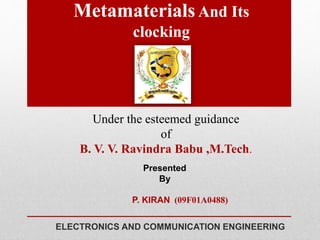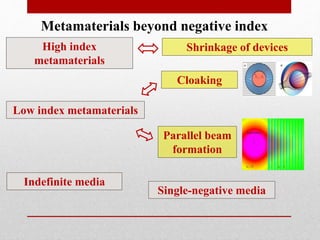Metamaterial
- 1. MetamaterialsAnd Its clocking Presented By P. KIRAN (09F01A0488) Under the esteemed guidance of B. V. V. Ravindra Babu ,M.Tech. ELECTRONICS AND COMMUNICATION ENGINEERING
- 2. Presentation Outline ’é¦ Introduction to Metamaterials ’é¦ Definition of Metamaterial ’é¦ How Metamaterials work ’é¦ Time Line ’é¦ What are Negative Index Metamaterials (NIMs)? Negative Index Metamaterial Features Negative Refraction ’é¦ Applications ’é¦ Conclusion
- 3. Introduction to Metamaterials Meta: Greek prefix meaning ŌĆ£BeyondŌĆØ
- 4. Introduction to Metamaterials: Why are they called Metamaterials? ’é¦ Existing materials only exhibit a small subset of electromagnetic properties theoretically available ’é¦ Metamaterials can have their electromagnetic properties altered to something beyond what can be found in nature. ’é¦ Can achieve negative index of refraction, zero index of refraction, magnetism at optical frequencies, etc.
- 6. Definition of Metamaterial: ŌĆ£MetamaterialŌĆØ coined in the late 1990ŌĆÖs ’é¦ Any material composed of periodic, macroscopic structures so as to achieve a desired electromagnetic response can be referred to as a Metamaterial very broad definition: ’é¦ Others prefer to restrict the term Metamaterial to materials with electromagnetic properties not found in nature ’é¦ Still some ambiguity as the exact definition
- 7. Veselago first studies the effect a negative permittivity and permeability has on wave propagation 1968 Pendry proposes wire structures to realize a negative permittivity1996 Pendry proposes Split Ring Resonators (SRRŌĆÖs) to realize a negative permeability Pendry proposes another wire structures to realize a negative permittivity 1999 2000 T I M E L I N E
- 8. How Metamaterials Work ŌĆó Example: How to achieve negative index of refraction ŌĆó negative refraction can be achieved when both ┬Ąr and ╬Ąr are negative ŌĆó negative ┬Ąr and ╬Ąr occur in nature, but not simultaneously ŌĆó silver, gold, and aluminum display negative ╬Ąr at optical frequencies ŌĆó resonant ferromagnetic systems display negative ┬Ąr at resonance rrn ’üź’üŁ’ĆĮ ’Ć© ’Ć® 1 ))(( ))(( 2/2/ 2/1 ’ĆŁ’ĆĮ’ĆĮ ’ĆĮ ’ĆĮ ’ĆŁ ’ĆŁ’ĆŁ ’ĆŁ’ĆŁ ’ü░ ’ü░’ü░ ’ü░’ü░ ’üź’üŁ j jj jj rr e ee ee
- 9. Negative Refraction n > 0 n > 0n < 0 SnellŌĆÖs Law at the interface between a negative index material and a positive index material: ti nn ’ü▒’ü▒ sinsin 21 ’ĆĮ ’āĘ’āĘ ’āĖ ’āČ ’ā¦’ā¦ ’ā© ’ā” ’ĆĮ ’ĆŁ it n n ’ü▒’ü▒ sinsin 2 11 Refracted beam will be opposite to the normal as shown in the animation above.
- 10. Metamaterials beyond negative index Low index metamaterials Indefinite media High index metamaterials Shrinkage of devices Cloaking Single-negative media Parallel beam formation
- 11. Applications ŌĆó Terahertz requirement ŌĆó Photonic applicati ŌĆó Cloaking devices ŌĆó Radar applications ŌĆó Mobile applications
- 12. conclusion Introduction of metamaterials in 1990ŌĆÖs opened new possibilities in electromagnetics. ’é¦ Successful implementation of metamaterial technology in the microwave spectrum. ’é¦ Inherent difficulties exist in fabricating optical metamaterials ’é¦ Most work to date related to modeling proposed designs
- 13. References: ŌĆó Smith, D. R., et al., Phys. Rev. Lett. (2000) 84, 4184 ŌĆó Pendry, J. B., et al., IEEE Trans. Microw. Theory Tech. (1999) 47, 2075 ŌĆó Veselago, V. G., Sov. Phys. Usp. (1968) 10, 509 ŌĆó www.google.com ŌĆó www.nanotechnology.bilkent.edu.tr/research%20areas /documents/mm-waveleft-handed.htm ŌĆó http://en.wikipedia.org/wiki/Metamaterial















